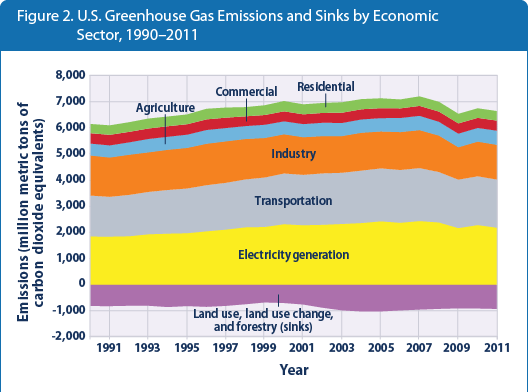Climate Change
Climate Change Indicators in the United States

* HFCs are hydrofluorocarbons, PFCs are perfluorocarbons, and SF6 is sulfur hexafluoride.
Data source: U.S. EPA, 2013 4

Data source: U.S. EPA, 2013 5

Data source: U.S. EPA, 2013 6
Key Points
- In 2011, U.S. greenhouse gas emissions totaled 6,702 million metric tons of carbon dioxide equivalents, an 8 percent increase from 1990 (see Figure 1).
- For the United States, during the period from 1990 to 2011 (see Figure 1):
- Emissions of carbon dioxide, the primary greenhouse gas emitted by human activities, increased by 10 percent.
- Methane emissions decreased by 8 percent, as reduced emissions from landfills, coal mines, and natural gas systems were greater than increases in emissions from activities such as livestock production. 2
- Nitrous oxide emissions, largely derived from vehicle emissions and agricultural soil management practices, such as the use of nitrogen as a fertilizer, increased by nearly 4 percent.
- Emissions of fluorinated gases (hydrofluorocarbons, perfluorocarbons, and sulfur hexafluoride), released as a result of commercial, industrial, and household uses, increased by 61 percent.
- Electricity generation is the largest U.S. emissions source, accounting for about 32 percent of total U.S. greenhouse gas emissions since 1990. Transportation is the second-largest source of greenhouse gas emissions, accounting for 27 percent of emissions since 1990 (see Figure 2).
- Emissions sinks, the opposite of emissions sources, absorb and store emissions. In 2011, 14 percent of U.S. greenhouse gas emissions were offset by sinks resulting from land use and forestry practices (see Figure 2). One major sink is the net growth of forests, which remove carbon from the atmosphere. Other carbon sinks are associated with how people use the land, including the practice of depositing yard trimmings and food scraps in landfills.
- Emissions increased at about the same rate as the population from 1990 to 2007, which caused emissions per capita to remain fairly level (see Figure 3). Total emissions and emissions per capita declined from 2007 to 2009, due in part to a drop in U.S. economic production during this time. Emissions decreased again from 2010 to 2011, largely due to the growing use of natural gas to generate electricity in place of more carbon-intensive fuels. 3
- From 1990 to 2011, greenhouse gas emissions per dollar of U.S. gross domestic product (GDP) declined by 35 percent (see Figure 3). This change may reflect a combination of increased energy efficiency and structural changes in the economy.
Background
A number of factors influence the quantities of greenhouse gases released into the atmosphere, including economic activity, population, consumption patterns, energy prices, land use, and technology. There are several ways to track these emissions. In addition to tracking overall emissions and emissions from specific industrial sectors in absolute terms, many countries also track emissions per capita.
About the Indicator
This indicator focuses on emissions of carbon dioxide, methane, nitrous oxide, and several fluorinated gases—all important greenhouse gases that are influenced by human activities. These particular gases are covered under the United Nations Framework Convention on Climate Change, an international agreement that requires participating countries to develop and periodically submit an inventory of greenhouse gas emissions. Data and analysis for this indicator come from EPA's Inventory of U.S. Greenhouse Gas Emissions and Sinks: 1990–2011. 1 This indicator is restricted to emissions associated with human activities.
This indicator reports emissions of greenhouse gases according to their 100-year global warming potential, a measure of how much a given amount of the greenhouse gas is estimated to contribute to global warming over a period of 100 years after being emitted (see table). For purposes of comparison, global warming potential values are calculated in relation to carbon dioxide and are expressed in terms of carbon dioxide equivalents. For additional perspective, this indicator also shows greenhouse gas emissions in relation to economic activity and population.
Indicator Notes
While this indicator addresses the major greenhouse gases emitted by human activities, it does not include other greenhouse gases and substances that are not covered under the United Nations Framework Convention on Climate Change but that still affect the Earth's energy balance and climate (see the Climate Forcing indicator for more details). For example, this indicator excludes ozone-depleting substances such as chlorofluorocarbons (CFCs) and hydrochlorofluorocarbons (HCFCs), which have high global warming potentials, as these gases are being phased out under an international agreement called the Montreal Protocol. There are also many natural greenhouse gas emission sources; however, this indicator includes only emissions that are associated with human activities.
Data Sources
Data for this indicator came from EPA's Inventory of U.S. Greenhouse Gas Emissions and Sinks: 1990–2011. This report is available online at: www.epa.gov/climatechange/ emissions/
usinventoryreport.html. The calculations in Figure 3 are based on GDP and population data provided by the U.S. Bureau of Economic Analysis and the U.S. Census, respectively.
Technical Documentation
- Download related technical information PDF (6 pp, 346K)





